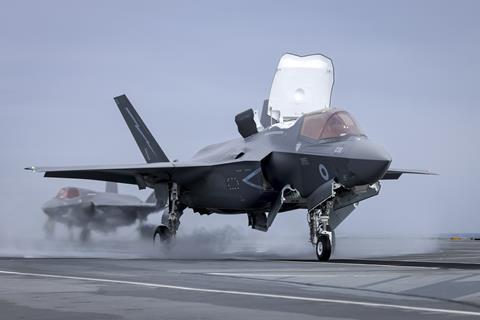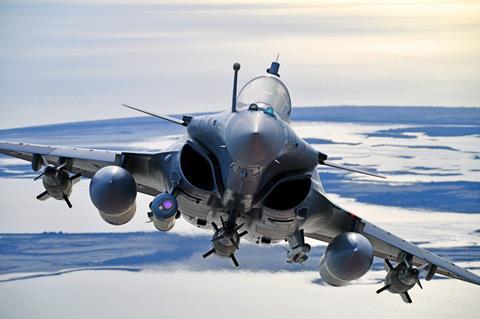The mix of Europe’s future combat aircraft fleet is starting to take shape, with two major developments under way and a late rally in orders for current-generation platforms buoying national industries that are determined to retain vital skills in the sector.
Partner nations France, Germany and Spain are advancing activities on their Future Combat Air System (FCAS) venture, including a New Generation Fighter (NGF).
And with its wings already spread beyond the region, the Global Combat Air Programme (GCAP) counts Italy, Japan and the UK as participants, working together on a project that will field capabilities – including a manned platform, named Tempest by the UK.

If all goes according to plan, GCAP should start to deliver operational capability from 2035, with the FCAS endeavour to reach the same milestone around 2040. The nations and leading companies behind both ventures also have an eye firmly set on attracting international customers – and potentially even additional partners.
Speaking at the EBACE business aviation show in Geneva in late May, Dassault Aviation chief executive Eric Trappier said he remains sanguine about the possible participation of additional nations in the FCAS programme.
Trappier has in the past been critical of the admission of more countries to the mix, fearing dilution of his company’s workshare, notably on the NGF, where it is prime contractor.
The recent addition of Belgium as an observer to the programme – a decision that opens a path to full membership – had threatened to potentially upset that balance. Last year, Trappier had fiercely opposed the move, due to Brussels’ selection of the Lockheed Martin F-35.
He now seems relaxed, however, stating: “As far as I’m concerned, why not?”
OBSERVER STATUS
Belgium’s position as an observer to the programme will not alter the workshare in the ongoing Phase 1B effort to design the NGF demonstrator, which also involves Airbus Defence & Space, representing both Germany and Spain.
“It is not going to change everything today. There is room available for the next step, which is a real development programme,” he adds.
While Dassault’s relationship with Airbus Defence & Space has previously shown signs of strain, Trappier says the work with its partner is “going well” as they strive to complete the definition phase next year.
A future Phase 2 contract covering the manufacture of a demonstrator is due to be signed in early 2026, paving the way for a first flight before the end of the decade.

By contrast, GCAP partners London, Rome and Tokyo appear to have remained in harmony on the activity since formally launching their pact in late 2022. Current areas of focus include working towards finalising the programme’s organisational and management structure, and agreeing the framework for industrial workshare and enabling future exports.
The UK has, for example, separately signed a framework agreement with Saudi Arabia to explore future collaboration in the combat air sector.
With industry participation being led by partners BAE Systems, Leonardo and Mitsubishi Heavy Industries, the next major programme milestone will involve the delivery of a so-called outline business case 2 proposal to the nations late this year.
That should be followed by investment approvals in 2025, which will unlock formal design and development activities.
Apart from GCAP, BAE is advancing work on its own supersonic technology demonstrator: the UK’s first since the Eurofighter-precursor EAP of the mid-1980s. Announced at the Farnborough air show in 2022, that activity should lead to a first flight during 2027. The company also aims to fly an autonomous collaborative platform demonstrator by mid-2026, with this to be similar in same size to its Hawk advanced jet trainer.
POLITICAL HEADWINDS
While all appears to be well for now, the FCAS and GCAP projects could encounter near-term headwinds, depending on the outcome of national elections taking place in France and the UK between late June and early July.
Industry sources note that the UK has more than one future fighter option open to it. Should a decision be taken to not continue with the GCAP activity – on cost grounds, for example – the nation could instead acquire more Eurofighter Typhoons, or take extra F-35s.
London has so far committed to buying 48 short take-off and vertical landing F-35Bs, against a long-standing programme of record requirement for 138 of the US type, and around 34 are currently in use. A decision on boosting its buy is not due before 2025, with details likely to emerge when the next UK government publishes a new Strategic Defence Review setting out its military investment priorities for the ensuing years.

Any decision to move away from GCAP would spell trouble for the UK’s aerospace industry.
“If we just buy more F-35s we won’t be in ‘the next big thing’: we’ll just be buying off the Americans,” one industry source says. “Things would atrophy.”
BAE and the UK Ministry of Defence stress that one of the GCAP effort’s key traits will be to ensure users have “freedom of operation and freedom of modification”. That is not the case on the F-35 programme, despite the UK being Washington’s sole Level 1 partner and producing around 15% of each Lightning II built, by value.
As an example, UK plans to integrate MBDA’s Meteor beyond-visual-range air-to-air missile with the F-35B have fallen years behind schedule; the work is now likely to happen as part of a future Block 4 upgrade to the type. The ability for a nation to conduct such work at the time of its own choosing would be safeguarded by the GCAP construct, proponents claim.
VITAL CONTRIBUTION
For its part, Lockheed stresses the vital contribution its F-35 will play in defending allies over the coming decades, noting that there will be around 600-650 of the type in service with European customers by 2035.
“The number one consideration is to stay ahead of the threat,” says JR McDonald, Lockheed’s vice-president F-35 business development, pointing to the likely schedule for nations to introduce aircraft via the GCAP and FCAS activities.
“How long before there are enough of those [sixth-generation fighters] that you have a fleet that is tactically significant? Now we’re at 2040, 2045 or maybe 2050.
“That tells me that for the next 25 years you’re going to fight with F-35s against the threat. So you had better make sure you have got the right F-35s, you have got enough of them and you have kept them modernised,” he says.
In the background, meanwhile, the US Air Force’s (USAF’s) Next-Generation Air Dominance (NGAD) programme is also advancing in secret. But as with Washington’s past position regarding exports of the Lockheed F-22 air superiority fighter – Japan had wanted to follow the USAF in purchasing the Raptor – it is unlikely to consider international sales of an NGAD system, at least initially.
Crucially for the region’s manufacturers, all three current European fighter types remain in production, with backlogs stretching for several years. Ensuring continuity of output until next-generation models arrive is a key focus, as this will ensure that strategically important skills are not lost during any gap.
Dassault is on a path towards increasing annual deliveries of its strong-selling Rafale to at least 22 units, with the company earlier this year saying that existing orders will support business until late next decade. Contracts in place cover aircraft for nations including France, Indonesia and the United Arab Emirates.

The four-nation Eurofighter programme also is seeing increased activity against targets of producing around 200 further examples and enabling a smooth transition to successor platforms.
In its case, a fair proportion of that total will come from its core nations: Germany and Spain have already committed to follow-on batches, and Italy looks set to do the same. Only the UK has no plan to buy more of the type, instead opting to retire its earliest, Tranche 1 examples without replacements.
EXPORT OPPORTUNITIES
Eurofighter partner companies Airbus Defence & Space, BAE and Leonardo are also pursuing additional export opportunities, with those including a 54-aircraft requirement in Saudi Arabia; the Rafale and Boeing F-15EX are also in contention.
In Sweden, meanwhile, Saab is producing Gripen Es for its domestic customer, along with single- and two-seat examples for Brazil. The nations have orders for 60 and 36 jets respectively, with launch operator Brazil already having seven locally-named F-39Es in service. Swedish air force introduction will begin in 2025.
Saab also earlier this year announced its first new Gripen sale since its selection by Brazil: of four C-model fighters to Hungary. To join 14 C/Ds already used by the nation’s air force, these had already been produced as among an undisclosed number of “white tail” aircraft built without confirmed customers.
Sweden is now considering its Future Fighter System needs, via a concept study being conducted by Saab and likely to run until 2030. A broad range of platform types are being explored, including a loyal wingman-type capability.

The ongoing conflict in Ukraine and fears around Russia’s potential ambitions for further territorial expansion have served as a reawakening to European nations regarding the importance of combat air.
Major investments such as those planned with the GCAP and FCAS efforts will be key to ensuring that European nations retain the industrial and operational skills needed to help deter – and if required, counter – such aggression.
Driven by the actions of Moscow, the new era of geopolitical tension has only served to underscore the need for air and decision superiority from current and future assets. Missing that target cannot be an option.


























